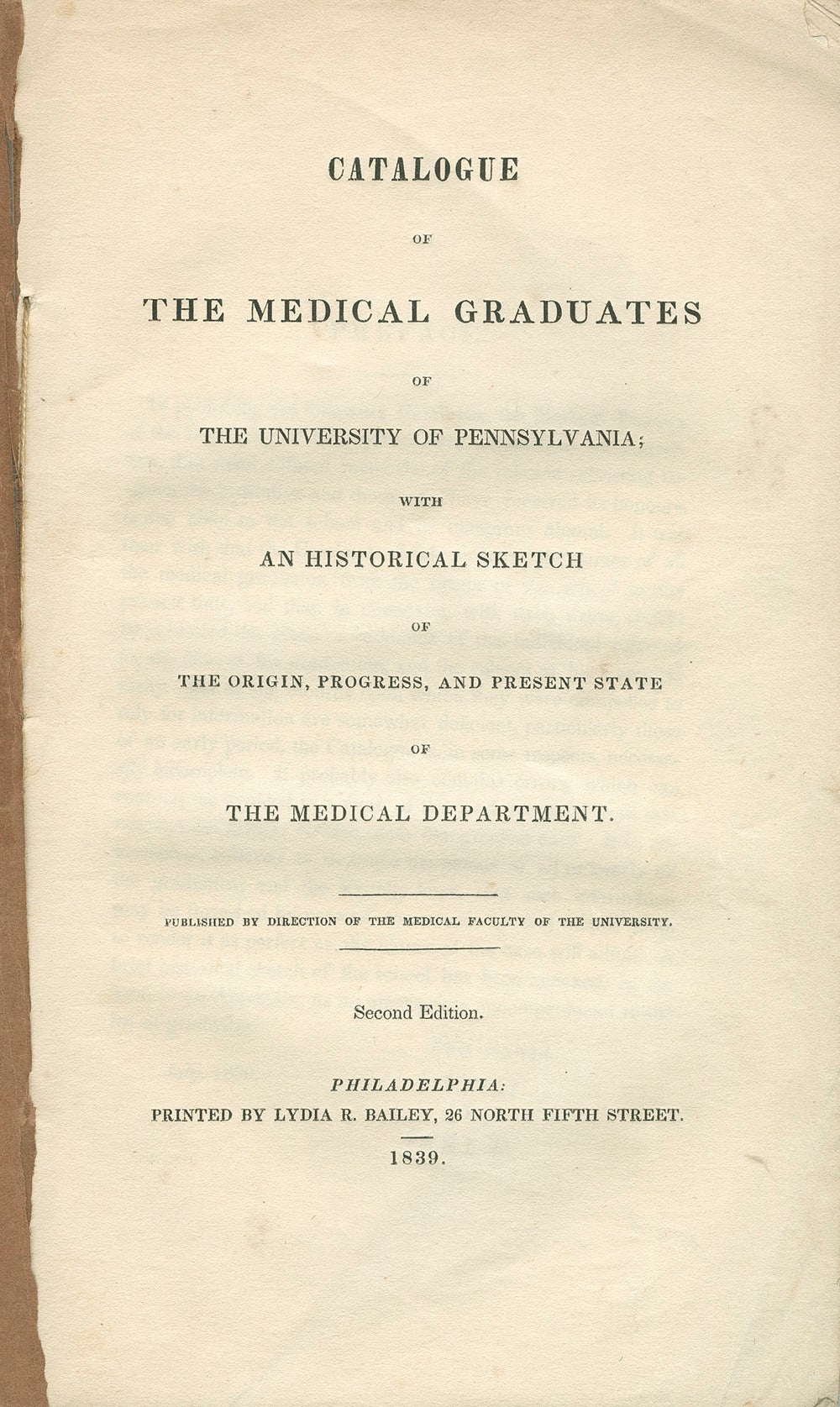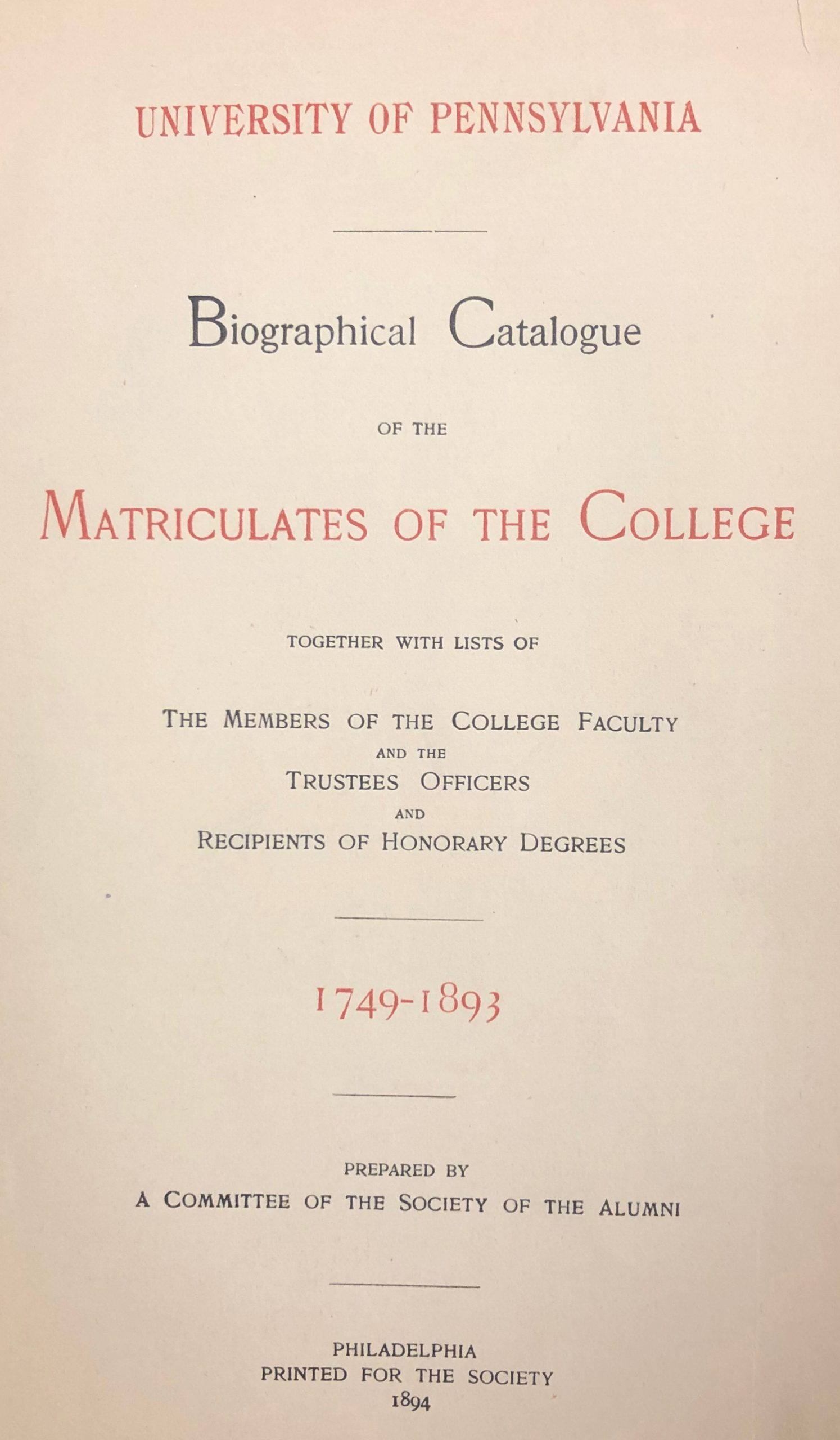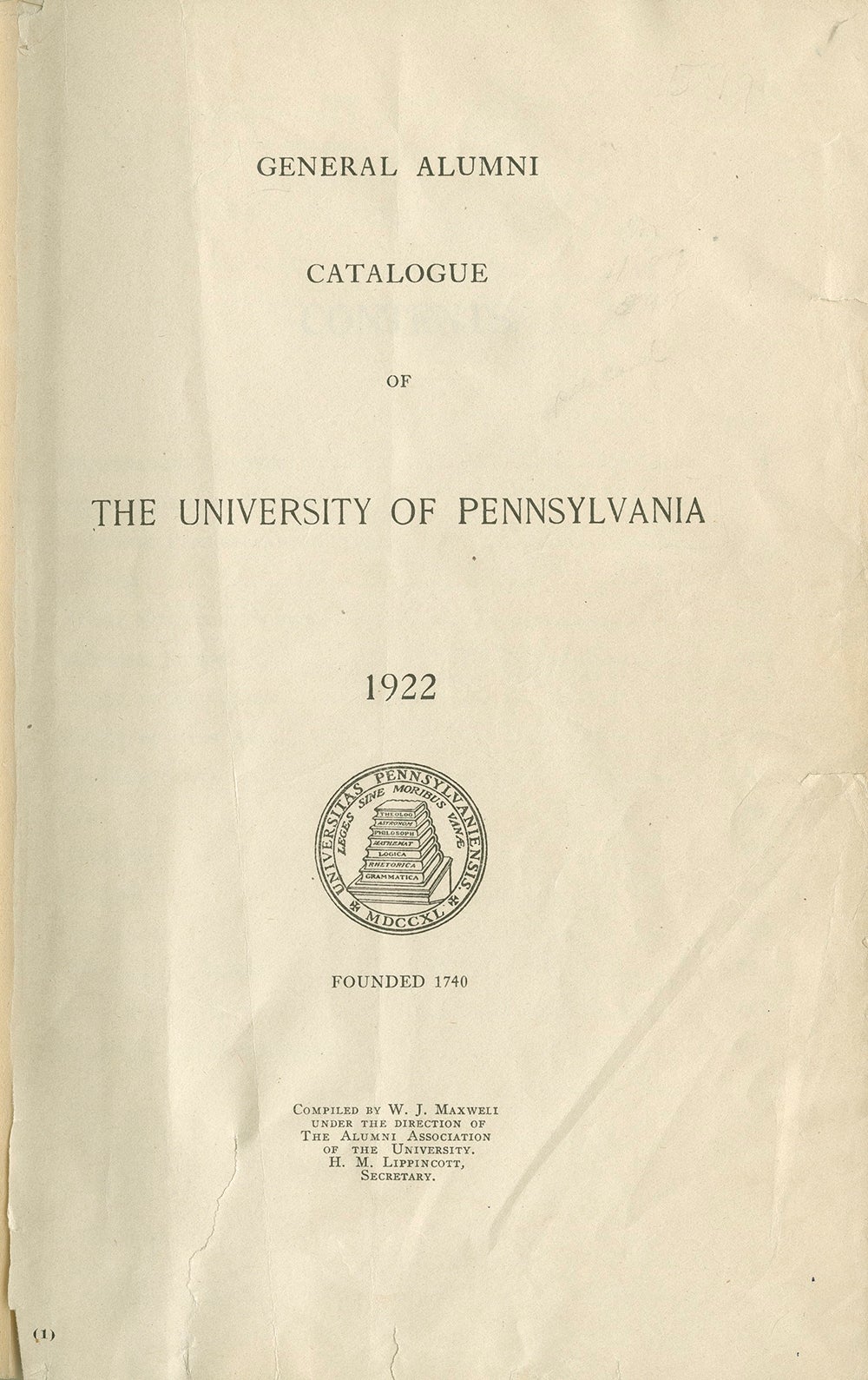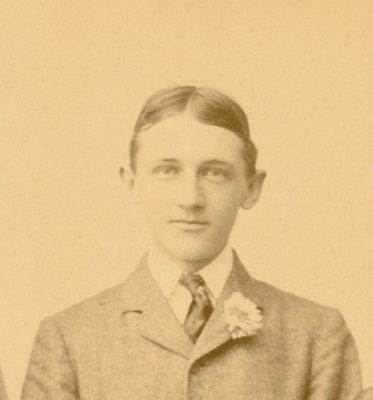Alumni Catalogues of the Past: Medical
The first published directory of any group of alumni appears to be Catalogue of the Medical Graduates of the University of Pennsylvania with an Historical Sketch of the Origin, Progress, and Present State of the Medical Department which was issued under an 1836 date (its actual appearance was in 1837) by the Philadelphia printer Lydia R. Bailey. The title page indicated its sponsorship by the faculty of the Department of Medicine, the largest and most vigorous division of the University. New material was soon found and the pioneer work was republished by Bailey in 1839.1
The publication was overseen by Dr. George Bacon Wood and Dean Dr. William Edmonds Horner.2 Horner’s wish to include the names of all graduates since 1768, with the date of their degree, place of residence and title of inaugural essay, caused him to beat the local bushes for information to add to the University records which the preface of the second printing of the Catalogue in 1839 admits to being “deficient.”
We cannot tell how many of the early “class lists” had survived down to 1836 but we do know that the “list of the names of the persons who attended my father’s lectures” was given by Hartman Kuhn, son of Dr. Adam Kuhn, to Dean Horner in July, 1839, “agreeably to your request.”3 Kuhn’s class lists, which began in May of 1768 – the son thought that the father’s rolls of 1768 and 1769 were complete – and terminated in 1797, had many lacunae and, in fact, were not overly useful for the 1839 printing since they included many non-graduates whose names would not be used.
The Kuhn list was, however, copied into a manuscript ledger, a “General Register” of medical students from 1762 to 1815, now designated UPA Pre-1820 Ms. 1575, one of the cornerstone sources of this work. Combined with them were similar rosters kept by Dr. Benjamin Rush for the years which run, also in a broken sequence, from 1779 to 1815-16.4 It had previously been thought that the “General Register” dated from about 1815 but it is now apparent that a date of about 1839 is more likely and that research for the 1839 issue of the Catalogue smoked out of hiding some of the very sources to which it would refer.
1. Although the preface of the Catalogue of the Medical Graduates is dated July 1836, an “Additional Catalogue” of the graduates of 1836 and 1837 was made part of the work so it did not appear earlier than the Commencement month of May 1837. It should be added that the Medical Department of the University of Pennsylvania (Philadelphia, 1841) presented a history and regulations but did not include an alumni catalogue. This was also reprinted, with additions, in 1844.2. Faculty meeting, 2 April 1836, vol. 3 (1828–1845), School of Medicine Faculty Minutes, UPC 2.1.
3. Letter of Hartman Kuhn to Dr. Horner, Philadelphia, 10 July 1839 in “General Register Med. Classes University Penna. From 1762 [sic] to 1815 Inclusive,” Ms. 1575, Archives General Collection Pre-1820, UPA 3.
4. “General Register Med. Classes University Penna. From 1762 [sic] to 1815 Inclusive,” Ms. 1575, Archives General Collection Pre-1820, UPA 3.
Alumni Catalogues of the Past: College
In the bibliography of “alumni biography,” the University of Pennsylvania work which is best known, and is, indeed, a historical source of some scholarly status, is a record compiled and published nearly a century ago by a Committee of the Society of Alumni under the editorial guidance of Persifor Frazer.University of Pennsylvania Biographical Catalogue of the Matriculates of the College Together with Lists of the Members of the College Faculty and the Trustees Officers and Recipients of Honorary Degrees, 1749-1893 (Philadelphia, 1894), as its title indicates, is an alumni catalogue of the College, not of the overall University.
It was the fifth publication to attempt to record the names, Class years and degrees of former students of the Arts and Sciences, as well as honorary degree recipients, for the institution and, in scope – as a directory not only of graduates but of matriculates – and in depth – as a biographical directory – it stood high above its predecessor volumes.
The four earlier publications appeared in 1849, 1877, 1880 and 1892. The first three were concerned only with graduates; the fourth alone took in some non-graduates, mostly of recent attendance. The publications of 1849 and 1880 were the more significant of the four and, in the present work, appear in the bibliography of sources while those of 1877 and 1892 do not.
The first cumulative alumni catalogue of the Arts department, or College, of the University of Pennsylvania was that of 1849. It was prepared by a “Committee of the Managers of the Society of the Alumni,” and listed Trustees (omitting, however, the significant 1779-1791 ex-officio, but active, members of the board), Provosts, Vice Provosts and members of the Faculty from 1749, the year of the adoption of the “Constitutions of the Publick Academy in the City of Philadelphia.” (The foundation of the University was then, and until well into the twentieth century, based on the date of the 1749 Constitutions, rather than on the year of the Charity School trust of 1740 or that of the Collegiate charter of 1755. The General Catalogue of the Officers and Graduates in the Department of Arts of the University of Pennsylvania: From 1749 Until 1849 was, in fact, considered a centenary publication. The greater part of the slender volume consisted of a chronological list of the recipients of degrees beginning in 1757: Bachelor’s, Honorary and Ad eundem, but the semi-honorary and gratiae causa Masters of Art were omitted. The aggregate of these was given as 1,120 Bachelor’s degrees and 177 “Honorary, and ad eundem.” A few biographical details were added in some instances. Needless to say, the General Catalogue of 1849 is replete with errors.
Interest in alumni catalogues languished for a quarter century. Then, on Commencement Day in 1875, a letter from five members of the Society of Alumni, led by lawyer Henry Budd, Jr., AB 1868, was circulated to living graduates. It announced the “preparation of a biographical catalogue of the Alumni of the College Department” by the signatories and enclosed biographical blanks which the recipients were invited to complete.5 Presumably, alumni response was good (the returned questionnaires do not survive) and resulted in the issuance of Catalogue of the Alumni of the University of Pennsylvania … 1749-1877, with content identical to the 1849 work brought down to its year of publication. Now added was the semi-honorary A.M. degree granted to most qualified Bachelors, and graduates of the “Scientific Department,” beginning with Henry Vethake Totten, whose BS was the first awarded (1854). Where readily available, capsule biographies of listees appeared as well as broader, simple identification of clergymen, members of the bar and engineers. It was under the sponsorship of the Society of the Alumni that the Catalogue of the Trustees Officers and Graduates of the Department of Arts and Science and of the Honorary Graduates of the University of Pennsylvania 1749-1880 appeared in 1880. More now was noted about everyone: Trustees, their offices, if any; Faculty: both dates of appointment and cessation of service; graduates: indication if deceased. An enumeration counted 1,760 graduates in Arts, 106 in Science, 186 Honorary and Ad eundem degree holders for a total of 2,052.
Another committee charged with a similar responsibility was created by the Society of Alumni in 1885. Its chairman was Dr. Persifor Frazer, AB 1862, the Historiographer of the Alumni Society of the College. The Frazer Committee intended to compile and publish a catalogue of the living graduates and matriculates of the College Department. The basis of the work was a “list” of matriculates stated to have been “kept since 1829” which was then in the possession of Professor of Latin Francis Aristide Jackson, AB 1848.6
Research, based largely at first on correspondence with living alumni and the retrieval from them of biographical questionnaires about themselves and fellow students, became the responsibility of Philadelphia physician Ewing Jordan, AB 1868, MD 1871, well-known for his expertise in history and genealogy, who got underway immediately.
By 1887, the Towne Scientific School and the Wharton School of Finance, College offshoots, had become so well established it was decided to identify non-graduate matriculates in their programs by use of rubrics. As the contemporary classes became larger, and with the decision to extend coverage in the catalogue back in time to 1757, it was anticipated that “research” would continue for three additional years. Frazer sought, and secured, a written commitment from the Society of Alumni for the eventual publication of the catalogue about which the latter were to become increasingly indifferent. As editor-in-chief, he was dismayed by the “pernicious example of torpor” demonstrated in large part by the most accessible alumni, those in Philadelphia. Undiscouraged, the Frazer Committee decided to go beyond the original scheme to produce a biographical handbook of living alumni and to take its catalogue back to the year 1754 – when the first collegiate instruction was actually offered, a year before the Charter of 1755. By 1890 research indicated that the number of matriculates in the College division since 1754 was 4,466.7
It seems likely that the necessarily slow pace of the biographical research being undertaken by the Frazer group, notably Dr. Jordan, with a consequent necessarily delayed publication date, was little understood by the Alumni Society. An interim publication, University of Pennsylvania Alphabetical Index of Matriculates of the Department of Arts and of Science From 1754 to 1890 (n.p., 1892), appeared as a spin-off of the larger work. It indicated that the emphasis in alumni biography had moved from “graduate” to “matriculate” but the arrangement, alphabetical instead of by Class year, made it a directory rather than a catalogue. The names were followed by addresses (of living alumni), both date of matriculation and Class year. However, the names of very few non-graduates before the middle of the nineteenth century were indicated.
As the scope of the larger work grew, the Society of Alumni continued to waffle on its commitment to the cost of publication but Provost Pepper, together with three benevolent members of the Society, John Barnard Gest, Edward de Veaux Morrell and Joseph George Rosengarten, opened a “guarantee fund” toward the desired end. The publication was released in the spring of 1894 and was sold both by subscription and in Philadelphia bookshops.
The 1894 Biographical Catalogue was the result of the research of campus records keepers, of historians and genealogists, who, while failing to provide specific references, at least presented a bibliography of the principal “authorities” used in the compilation of the capsule biographies of alumni. (The institutional records used were not identified.)
The Frazer compilation, despite its defects, is a pioneer work in both American educational biography and in university alumni bibliography. It was not, and, indeed, did not intend to be an in-depth biographical encyclopedia of early degreed (men) alumni falling within a limited span of years in the nature of two contemporary works of impeccable scholarship. John Langdon Sibley’s Sibley’s Harvard Graduates: Biographical Sketches of Those Who Attended Harvard College a majestic dictionary whose first volume in an ongoing series appeared in 1873 and Franklin Bowditch Dexter’s Biographical Notices of the Graduates of Yale College with Annals of the College History, of which the first volume (of six) was published in 1885, were true biographical dictionaries. Frazer and his committee covered a far longer time span, listing both graduates and non-graduates of the Arts curriculum of the University of Pennsylvania during the entire life span of the institution. Theirs was a concise manual, a directory rather than a dictionary, which was largely based on sound sources but did not give specific documentation for each fact it contained. Indeed, information on members of some fifty classes came largely from the individuals themselves who made up two-thirds of the entries in the published volume.
Nonetheless, Pennsylvania alumni biography took a giant step forward in 1894.
5. 1874, Alumni Biography, 1875–1929, Archives General Collection. UPA 3 Post-1820.
6. No such consecutive matriculation record now exists for the College. Lists or registers survive for 1826, 1828–1830, 1830–1859, 1856–1860, 1867–1878 and overlapping matriculation, diploma or grade records thereafter (see UPB 1.45).
7. The Pennsylvanian, 28 May 1890, p. 58. This count was printed as 4,366 but correct by the committee. The true figure is close to the one given here.
Alumni Catalogues of the Past: General
A generation later the University was ready for a new alumni catalogue, the first general catalogue in its history, which would embrace all of the then nine Schools or divisions of the institution and would bring up-to-date the list of recipients of honorary degrees and of officers and trustees.
The production of The General Alumni Catalogue of 1917 was directed by Horace Mather Lippincott, Ph.B. 1897, longtime Secretary of the General Alumni Society, editor of The Alumni Register and a recognized historian of the city and state. The compilation of the volume, however, was farmed out in 1916 to a firm of directory publishers, R.L. Polk & Co., of New York.The General Alumni Catalogue followed the pattern of the 1894 Biographical Catalogue of the College in its listing of both graduates and non-graduates of the College and of its Towne, Wharton and (fledgling) Education Schools components. Of the Graduate, Law, Medical, Dental and Veterinary Schools, however, only degree recipients were included in the new work.
In the 1917 publication, the capsule biographies which characterized the 1894 Biographical Catalogue of the College were reduced, for the dead, to date and place of death if known; living alumni rated some biographical detail, usually more professional than personal/genealogical in nature, and this pattern maintained for all Schools. Of great value was the use of full names, an advance upon the practice of earlier catalogues of the professional schools, to largely make do with first names and middle initials.
The work was completed by Polk associate W. J. Maxwell in just one year. The result was a tightly-packed work of 1,332 pages which, not surprisingly, included information on the General Alumni Society and of the subsidiary Associated Pennsylvania Clubs, world-wide. New, and of great value for use then, and since, was a geographical index of living alumni and a complete name index showing School and Class.
Of course, the omission of thousands of non-graduate alumni in the professional schools, and a lesser number of unsuspected members of the College during its first half century, meant that the 1917 catalogue was far from complete. Even a few recipients of “honorary” (in most cases, actually ad eundem gradum) medical degrees of the earlier period were overlooked. By and large, however, the University of Pennsylvania finally had a respectable register covering the whole range of its alumni.
The magnitude of the work not having daunted R.L. Polk & Co., the General Alumni Society contracted with the firm for an updated volume five years later. The Lippincott-Maxwell partnership was resumed and The General Alumni Catalogue of the University of Pennsylvania, a boiled down (1,069 pages, smaller type face) but very similar version of its predecessor, appeared in 1922. Attempts were made in subsequent years to repeat the performance, perhaps, even, to improve upon it.
In 1926 a small new committee, chaired by Edward Warloch Mumford, BS 1889, the Secretary of the University, met and decided to publish a new alumni catalogue which would be “a complete list of every student ever matriculated in the University of Pennsylvania!” This meant, of course, inclusion of the non-graduates of all the professional schools, including the Medical School. Perhaps because of the availability, and currency, of the two recent publications, interest in the Mumford project died. Another internal effort was made, this time by the Alumni Records Office. Personnel there worked from July 1927 to March 1929 on updating files of all students since 1850, the earliest class of which one or more members were still alive. It was planned, in March of 1929, to send out a questionnaire card to all living alumni toward the announced goal, the publication of a new alumni directory. That mailing seems never to have occurred. Reading between the lines, one surmises that some sense of rivalry between administrators in Alumni Records and Secretary Mumford killed both projects.
No other catalogues of any major block of alumni except honorary degree recipients have appeared during the past half century.







